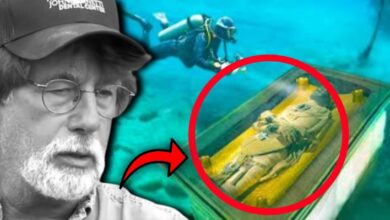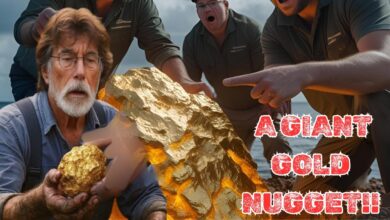Oak Island’s Curse: Unearthing Canada’s Greatest Buried Treasure |Hidden Chapter
Oak Island's Curse: Unearthing Canada's Greatest Buried Treasure |Hidden Chapter

Imagine an unassuming tree-covered island off the coast of Nova Scotia, Canada. On the surface, it looks like any other speck of land in the vast Atlantic. But beneath its tranquil facade lies a mystery that has captivated treasure hunters, obsessed historians, and claimed lives for over two centuries.
This is Oak Island, home to the legendary Money Pit, a colossal booby-trapped shaft rumored to contain anything from pirate gold and ancient religious artifacts to Marie Antoinette’s lost jewels or even Shakespeare’s original manuscripts. But with every step closer to the supposed treasure, the island seems to fight back, protecting its secrets with a deadly curse.
What hidden riches lie beneath the soil? And what price has been paid in the relentless quest to unearth Canada’s greatest buried treasure?
The Oak Island Enigma began in 1795 when a 16-year-old Daniel McInness stumbled upon a circular depression on the island’s eastern end. What started as youthful curiosity quickly escalated into a full-blown obsession. With friends John Smith and Anthony Vaughn, McInness began to excavate, unearthing layers of meticulously placed logs every 10 ft.
This wasn’t a natural formation. It was a complex engineered shaft clearly designed to conceal something extraordinary. Their initial digging revealed pickaxe marks on the walls, leading them to believe they were on the verge of a magnificent discovery. Little did they know they were scratching the surface of a puzzle designed to thwart even the most determined treasure seekers.
As the original treasure seekers dug deeper, the Money Pit began to reveal its sophisticated and sinister secrets. At 90 ft, they hit a layer of impenetrable clay. But upon breaching it, the shaft immediately flooded with seawater. This was the first hint of the legendary booby traps that would plague every future excavation.
It suggested an elaborate flood tunnel system, possibly designed by master engineers to protect the treasure from intruders. This early setback, rather than deterring them, only intensified their conviction that something truly monumental lay beneath the waters, guarded by an ingenious and relentless defense mechanism.
The story of Oak Island is not just about buried treasure. It’s also entwined with a chilling legend — the Curse of Oak Island. Folklore states that seven men must die before the treasure can be found. As of today, six lives have been tragically lost in pursuit of the island’s secrets.
A grim tally that fuels both apprehension and an almost morbid fascination. These deaths, often due to accidents like shaft collapses or drowning, seem to underscore the island’s inherent dangers, reinforcing the belief that the treasure is not merely hidden, but actively protected by an unseen force or an ancient malevolent design.
Over the past two centuries, countless expeditions have descended upon Oak Island, each more determined and often better funded than the last. Notable figures, including a young Franklin Delano Roosevelt — who would later become U.S. president — formed syndicates to fund searches.
Mining companies with vast resources brought heavy machinery and advanced drilling techniques. Yet, despite immense effort, incredible expense, and revolutionary technology, the treasure remains elusive. Each expedition has uncovered tantalizing clues — ancient coins, fragments of parchment, mysterious stone carvings — but never the grand prize, leading to an ever-growing pile of questions.
One of the most perplexing discoveries associated with the Money Pit is the infamous 90 ft stone. Found in 1804 at a depth of 90 ft, this large flat stone was reportedly inscribed with a cryptic message. Translated by a linguistics professor in the mid-19th century, it purportedly read: 40 feet below, 2 million pounds are buried.
While the original stone has since been lost or possibly stolen, its alleged inscription has become a cornerstone of the Oak Island legend, a tangible clue that has fueled generations of treasure hunters with the hope that the wealth truly exists, buried just a little deeper.
The theories about who buried the treasure on Oak Island are as numerous and varied as the treasure hunters themselves. Some believe it was Captain Kidd, the notorious pirate who supposedly left vast amounts of loot across the Caribbean and Atlantic. Others point to the Knights Templar, suggesting they fled Europe with priceless artifacts and religious relics, burying them on the island to protect them from persecution.
Even the lost jewels of Marie Antoinette, spirited away during the French Revolution, have been suggested as the island’s secret cargo, transported to the New World for safekeeping. Each theory, while speculative, adds another layer of intrigue to the already complex narrative.
The most compelling theory regarding the Money Pit’s creators points to skilled French military engineers from the 18th century, perhaps in collaboration with the Knights Templar. Their expertise in defensive construction, including intricate water traps and subterranean tunnels, aligns perfectly with the booby-trapped nature of the Money Pit.
The sheer scale and complexity of the shaft — requiring a vast amount of labor and sophisticated engineering knowledge — suggests a well-organized, well-funded operation far beyond the capabilities of a typical pirate crew. This theory posits that the treasure is not just gold, but historical artifacts of immense value, requiring the highest level of protection.
One of the most persistent obstacles on Oak Island has been the ingenious flood tunnels. It is believed that two main tunnels — known as the South Shore and Smith’s Cove flood tunnels — lead directly from the ocean to the Money Pit. These tunnels, constructed with astonishing precision, are designed to flood the Money Pit and any adjacent boreholes, making excavation nearly impossible.
Despite modern efforts to block these tunnels or drain the pit, they have consistently thwarted treasure hunters, reinforcing the notion that the treasure’s protectors were master engineers determined to keep their secrets buried forever.
The island’s history is peppered with mysterious structures and clues that fuel the treasure hunt. Beyond the Money Pit, there’s the Stone Triangle, a formation of boulders that some believe point to specific locations or are part of a larger navigational code. Nolan’s Cross, a series of large stones arranged in a crucifix pattern, has also been discovered, its purpose debated for decades.
Are these merely natural formations, or are they deliberate markers left by the original depositors — guiding future generations to the treasure or perhaps warning them away?
The hit television show The Curse of Oak Island has catapulted the mystery into mainstream consciousness, attracting millions of viewers worldwide. Starring brothers Rick and Marty Lagina, the show follows their ongoing efforts to solve the 200-year-old riddle. While some criticize the show for its slow pace and lack of definitive answers, it has undoubtedly generated unprecedented interest in the island, bringing new funding, new technology, and fresh perspectives to the seemingly endless quest.
It also highlights the extreme dedication and personal cost involved in such a prolonged pursuit.
… and the hidden water channels could explain the flooding phenomena in the Money Pit without human intervention. Skeptics argue that the multiple layers of timber, stones, and unusual materials are simply the result of centuries of natural activity or logging. However, to treasure-hunting enthusiasts, even these “natural” explanations deepen the mystery: did nature accidentally create a perfect trap, or was it the work of some highly skilled, deliberate hand?
Recent discoveries at Smith’s Cove and around the Money Pit add more layers of intrigue. Layers of sand, coconut fiber, and strange filtration structures suggest a highly sophisticated system, one that would have required advanced engineering knowledge—possibly centuries ahead of its time. Artifacts such as 17th-century coins, pottery shards, and human bones provide concrete evidence of long-term human activity, yet the questions “Who were they?” and “What did they leave behind?” remain unanswered.
Oak Island contains other peculiar landmarks that cannot be ignored:
-
Stone Triangle – a trio of stones forming a triangle, possibly a directional marker or symbolic design.
-
Nolan’s Cross – stones arranged in a cross formation, the purpose of which is still unknown.
Each minor discovery adds complexity to the story, reinforcing the idea of intentional construction while keeping open the possibility that countless artifacts remain buried.
Modern technology has renewed hope for solving Oak Island’s mysteries:
-
Ground-penetrating radar (GPR) can detect hidden structures underground without excavation.
-
Sonar systems and drones survey the seabed and thermal patterns, searching for sunken ships or tunnels.
-
Geological analysis helps distinguish natural formations from human-made shafts and channels.
Despite these advances, Oak Island remains treacherous. Heavy rains, tides, and shifting geology constantly challenge excavation efforts. Risks are not just mechanical—historical accounts hint at threats to human life, echoing the legend that “seven must die before the treasure reveals itself.”
Ultimately, Oak Island symbolizes humanity’s curiosity and obsession with hidden wealth. It is more than a treasure hunt; it is a test of intellect, patience, and the ability to unravel mysteries left by nature—or by men. Whether the treasure truly exists, or if centuries of searching have been nothing more than a game of legend and time, the answer still lies buried beneath the island’s soil, water, and history.








